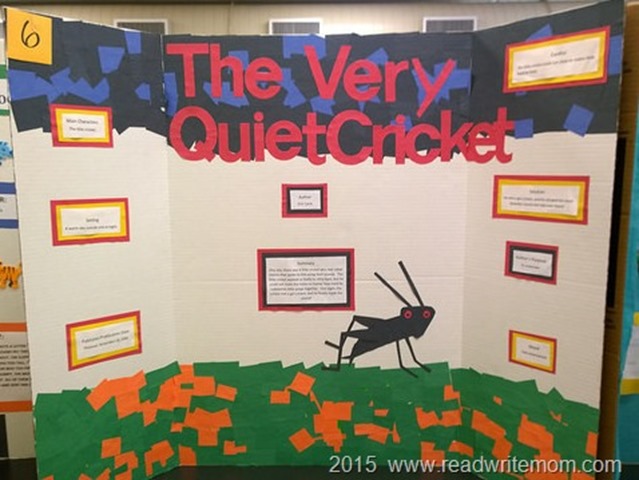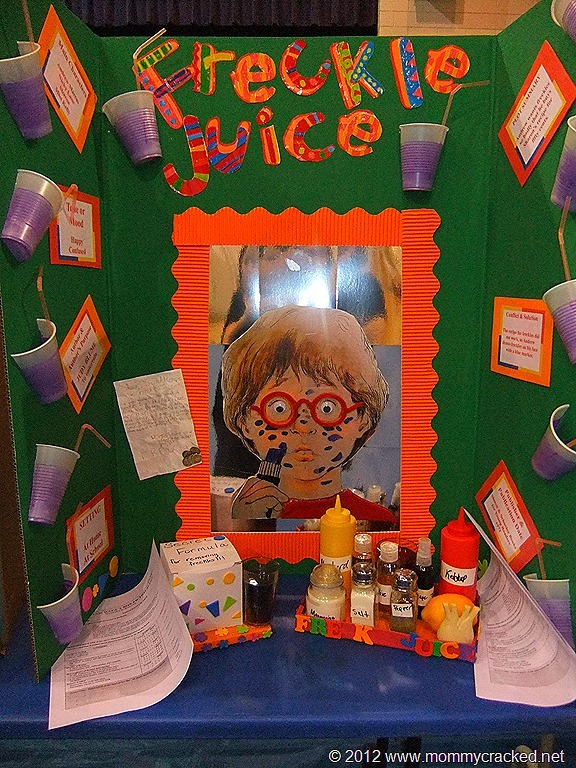Another school year has started and it’s already time for me to start thinking about putting together plans for our school reading fair. I get so excited every year about seeing all of the insanely creative projects my students come up with. However, I know it can be quite a bit of work for parents, especially if your child is younger or if you’re like me and just not artistically creative. Maybe you and your child are great at the creative part of putting together a reading fair project board, but you struggle with deciding on a book or even the part of presenting that book to the judges. This summer I sat down and put together 20 reading fair project tips and tricks from a librarian that I hope will help you and your child out in whatever area you struggle with when it comes to reading fairs.
1. Don’t be afraid to do a project on a seasonal book (Christmas, Halloween, Thanksgiving, etc.). Seasonal books can make decorating a project board so easy and fun. You may have to plan ahead for any decorations you might want to use to decorate your project board to make sure they are available. As I’m sharing this with you, Halloween is just around the corner. The decorations are plentiful now, with Thanksgiving and Christmas items already arriving in stores as well. Last year I had the pleasure of judging a reading fair at another school and the top prize went to a child who did a project on a Halloween-themed book. It was an amazing project and I wish I had taken a picture of it.
2. Less can be more! If you aren’t very crafty, don’t panic! This project was made entirely of construction paper and is still one of my very favorite projects I have ever seen.
3. Don’t choose a book that you aren’t excited about. It definitely shows when the judges come to ask questions about your project and you are less than enthusiastic about what book you have read. Pick something you like a whole lot, or even love! You’ll enjoy talking about it much more.
4. Double-check your work. Make sure everything required is on the project board. Nothing hurts my heart worse on reading fair day than to be so excited about an awesome project board that was beautifully presented but then have to deduct ten points for a missing story element. Ouch.
5. When the judges come around, don’t read the plot summary of your book directly from the project board. It’s ok to refer back to it if you get a little nervous or stuck, but you should be able to tell about all of the major points of your story without having to read from a script. It all goes back to picking that book you love!
6. Parent, please do not do your child’s project. By ALL means, help your child, especially if they are young, but also let them take some ownership of the project. Let them draw, glue, or whatever else is age-appropriate. I once judged a reading fair and complimented a child on the beautiful artwork on her board. She proudly told me her mom paid someone to have it drawn for her! YIKES!! Kids will tell it all! Ha-ha!
7. DO NOT COPY PROJECTS YOU SEE ONLINE. I share a lot of pictures of reading fair projects here. I can recall of three instances seeing one particular project copied down to the very fine details at reading fairs I have judged in the past. Beautiful projects, but not authentic in the least. By all means, get a little inspiration for your project if you want to do the same book, but just know that some judges can spot copied projects a mile away. Don’t risk getting disqualified!
8. Speak up and speak clearly when talking to the reading fair judges! As a judge, I get so excited when I come across a student who LOVES their book and is so excited to tell me all about it. I’m pretty shy myself and speaking is not my area at all. However, just remember the judges are interested in what you have to say. They are not there to “grill” you on your book, but to basically get an idea of the book and how it inspired your project. Did it inspire you to do anything else outside the project? I got to talk to a student who did their project on The Watson’s Go to Birmingham. He loved the book, but what stuck with me so much was how he told the judges that it had inspired him and his family to plan on taking a trip to Birmingham in the future so they could visit historic Civil Rights monuments and places of interest. Wow!
9. Don’t be afraid to choose a book that isn’t “popular”. Some of the best projects I’ve seen were books I had never heard of. The enthusiasm of the students presenting these books made ME want to read them and purchase copies for my own library.
10. Make sure your project represents the right category for your book. I’ve seen beautiful projects get points deducted because it was a non-fiction reading fair book project entered into a fiction category. When in doubt, show your book to your teacher or librarian before you start.
11. If allowed, use props. Items that go along with your book really make a project stand out and are great conversation pieces. Here is an example of props used well:
12. Dress up! If you are allowed to dress like a character from your book, go for it! It adds a little “extra” and can be fun.
13. Make sure your project is sturdy. If items are falling off your reading fair board, points might be deducted. Your project may advance to a regional or state competition, so make sure it can withstand being transported safely.
14. Choose an age-appropriate book. Make sure the subject matter isn’t too mature or too below your child’s reading level. This can be tricky, especially if you have a child that reads many grade levels above their peers. I once judged a reading fair where an elementary student did a project on a book that I thought might be more appropriate for a high school student. Now, maybe I’m just old school and the most risqué thing I ever read was a Sweet Valley High book in junior high, but I just couldn’t help but think that this little girl was reading things she probably shouldn’t at that age. Again, it’s a tricky balance.
15. Take advantage of reading fair help hours and workshops. At my previous school, we offered a help hour after school around 5:00 PM so students and their parents could come to school and get some help, use the die-cut machines, or get a little creative direction from the art teacher. I made sure to have reading fair boards from previous years out for display so the kids and parents could get an idea of exactly what should be on their board.
16. Colored project boards really make a project pop. If you can’t find any colored project boards, you can paint your board any color you like. Fabric paint and spray paint work well on the boards that are made from cardboard, not foam.
17. Have a copy of the book in front of your project. Judges love to actually see the book you chose and it helps them get a better idea of the book’s topic.
18. Having trouble choosing a book? Ask your school or community librarian for ideas. They can point you in the right direction and help you choose the perfect book that you will actually enjoy reading.
19. Supplies for your reading fair project board don’t have to be expensive! I have seen students use sticks, cotton balls, and props they already have at home. Check out this super cute winning project that used peas and sponges:
20. Follow all reading fair rules. Make sure your project board meets the height requirements, that you have permission to use props and any other specific guidelines that have been set forth.
I hope these tips and tricks for reading fair projects will help you out along the way and give you some inspiration. Ready to start your own reading fair project? Check out these posts for more great reading fair inspiration. Be sure and follow me on Pinterest and never miss a reading fair update!





Can you post or share directions given to students to complete a reading fair board? I’d like to try this with my students!